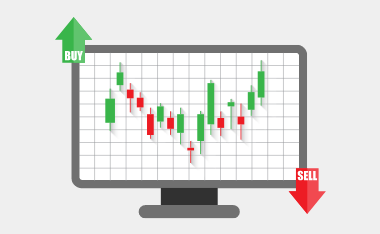Forex Trading Bear Market

Forex trading in a Bear Market can be challenging for new and even experienced forex traders.
Forex is a dynamic and ever-changing market where market trends can shift from bullish to bearish.
However, with the right strategies and mindset, traders can navigate bear markets successfully, thrive, and capitalise on profitable opportunities.
This article will explore effective strategies for thriving in forex trading bear markets, helping traders adapt to changing market conditions and achieve their trading goals.
Understanding Forex Trading Bear Markets
Before delving into strategies, it is crucial to understand what constitutes a bear market in forex trading.
In simple terms, a bear market refers to a prolonged period of declining prices and negative sentiment in the market.
It is characterised by lower highs and lower lows, with sellers dominating the market and pushing prices downward.
Various factors, such as economic downturns, geopolitical tensions, or shifts in market sentiment, can trigger bear markets.
During these market conditions, traders often face increased volatility, extended downward trends, and a generally pessimistic outlook.
Position Forex Trading in a Bear Market
Bearish position trading is a trading strategy that aims to capitalise on a sustained downward trend in the market.
Position traders typically hold their positions for longer periods, ranging from weeks to months, to take advantage of significant market movements.
Traders employing a bearish position trading strategy analyse macroeconomic factors, market trends, and fundamental indicators to identify potential opportunities for short-selling or taking other bearish positions.
They may look for weakening economic conditions, negative news releases, or deteriorating market sentiment that could contribute to a downward trend.
Once a bearish position is established, traders may set wider stop-loss orders to allow for market fluctuations while still protecting against excessive losses.
Profit targets are often set at significant support levels or based on the trader’s analysis of potential price targets.
Successful bearish position trading requires patience, discipline, and careful risk management to ride out market fluctuations and capture the anticipated downward move.
Swing Forex Trading in a Bear Market
Bearish swing trading is a strategy that seeks to profit from short- to medium-term downward price swings within a more significant bearish trend.
Swing traders aim to capture price reversals after temporary upward moves, known as bearish retracements, within the overall downward trend.
Swing traders use technical analysis tools such as trendlines, moving averages, and oscillators to identify potential swing trading opportunities.
They look for bearish chart patterns, bearish candlestick formations, or other signals that suggest a possible reversal or continuation of the bearish trend.
When entering a bearish swing trade, traders typically set stop-loss orders above recent swing highs to protect against unexpected price reversals. Profit targets are often set at nearby support levels or based on the trader’s analysis of potential price targets.
Traders may also use trailing stop-loss orders to lock in profits as the trade continues to move in their favour.
Successful bearish swing trading requires a combination of technical analysis skills, risk management, and the ability to identify high-probability trade setups within the context of the overall bearish market sentiment.
Day Forex Trading in a Bear Market
Bearish day trading is a strategy that involves taking short-term bearish positions within a single trading day.
Day traders aim to profit from intraday price movements by entering and exiting trades within the same trading session.
Day traders who focus on bearish opportunities look for short-selling opportunities or take advantage of downside momentum during a bearish market phase.
They closely monitor price action, volume, and intraday patterns to identify potential short-selling opportunities.
Day traders often use tight stop-loss orders placed just above recent swing highs or resistance levels to manage risk.
Profit targets are typically set at nearby support levels or based on the trader’s assessment of intraday price targets.
Bearish day trading requires strong technical analysis skills, the ability to be decisive, and the discipline to adhere to trading rules and risk management strategies.
Traders must be vigilant and actively monitor their positions throughout the trading day to capitalise on short-term bearish opportunities.
Intra Day Forex Trading in a Bear Market
Bearish intraday trading is a strategy that focuses on short-term bearish trades within smaller timeframes, such as minutes or hours.
Intraday traders seek to profit from intraday price fluctuations and capitalise on bearish trends that emerge within shorter time periods.
Traders employing a bearish intraday trading strategy use technical analysis tools, including chart patterns and indicators, to identify short-selling opportunities or take advantage of downward price movements.
They may also monitor news releases or market events that could contribute to bearish price action during the intraday session.
Risk management is crucial in bearish intraday trading, as traders must react quickly to changing market conditions.
Stop-loss orders are placed at strategic levels to limit potential losses, and profit targets are set based on intraday support levels or the trader’s assessment of potential price targets.
Successful bearish intraday trading requires discipline, adaptability, and the ability to be decisive based on real-time market information.
Traders must also be mindful of market liquidity and volatility, as these factors can significantly impact intraday trading outcomes.
Strategy 1: Trend Following
One effective strategy for thriving in forex trading bear markets is trend following.
This approach involves identifying and trading in the direction of the prevailing bearish trend. By recognising the lower highs and lower lows, traders can enter short positions to capitalise on downward price movements.
Trend-following strategies often employ technical indicators, such as moving averages, to confirm and validate the bearish trend.
The goal is to ride the trend and stay in a profitable trade as long as the downward momentum persists.
However, it is essential to implement risk management techniques, such as setting appropriate stop-loss orders, to protect against potential reversals or unexpected market fluctuations.
Strategy 2: Breakout Trading
In bear markets, price consolidation and breakdowns are expected.
Breakout trading is a strategy that employs identifying key support levels that, when breached, can trigger significant downward movements.
Traders utilising this strategy aim to enter short positions when prices break below critical support levels, expecting further downward momentum.
To implement breakout trading effectively, traders often use technical tools, such as support and resistance levels, chart patterns and trend lines, to identify potential breakout points.
Additionally, confirmation from other indicators or momentum oscillators can enhance the probability of a successful breakout trade.
Strategy 3: Risk Management
Effective risk management is crucial for any trading strategy but becomes even more critical in bear markets.
During periods of heightened volatility and uncertainty, it is essential to protect capital and manage risk diligently.
Traders should consider implementing the following risk management techniques:
Proper Position Sizing
It is advisable to reduce position sizes in bear markets to account for increased volatility and potential losses.
By allocating a smaller portion of the trading capital to each trade, traders can limit their exposure and minimise the impact of adverse market movements.
Setting Stop-Loss Orders
Placing stop-loss orders is a key risk management tool in bear markets.
These orders automatically trigger an exit from a trade if prices move against the desired direction beyond a predetermined level.
By setting appropriate stop-loss levels, traders can limit potential losses and protect their capital.
Diversification
Another risk management strategy is diversification which can help traders thrive in bear markets.
By spreading trading capital across different currency pairs or even other asset classes, traders can reduce the concentration of risk.
Diversification allows for exposure to multiple opportunities and can help offset losses in specific trades or currencies.
Forex Trading Bear Market Candlestick Patterns
Candlestick patterns provide valuable insights into market sentiment and can be especially useful in bear markets.
Bearish candlestick patterns indicate potential trend reversals or continuation of the bearish trend. Some common bearish candlestick patterns include:
Bearish Engulfing Pattern
The bearish engulfing pattern occurs when a large bearish candle fully engulfs the previous smaller bullish candle.
This pattern suggests a shift in market sentiment from bullish to bearish and indicates potential downward momentum.
Evening Star Pattern
The evening star candlestick pattern is a formation of three candlesticks: a large bullish candle, a small indecisive candle, and a large bearish candle.
This pattern suggests a potential reversal of the upward trend and signals the start of a bearish phase.
Shooting Star Pattern
A small-bodied candle characterises a shooting star pattern with a long upper and short lower wick.
This bearish pattern indicates that sellers were able to push prices lower during the trading session, suggesting a potential reversal from the bullish trend.
These are just a few examples of bearish candlestick patterns.
Traders should familiarise themselves with various candlestick patterns and use them in combination with other technical analysis tools to make informed trading decisions.
Forex Trading Bear Market Chart Patterns
In addition to candlestick patterns, bearish chart patterns can provide valuable up-to-date insights into market trends and potential trading opportunities.
Some common bearish chart patterns include:
Head and Shoulders Pattern
The head and shoulders pattern is a reliable bearish reversal pattern. It consists of three peaks, with the middle peak (known as the head) being higher than the other two (the shoulders).
The neckline is drawn by connecting the lows between the peaks.
A break below the neckline suggests a potential trend reversal and the start of a bearish phase.
Descending Triangle Pattern
The descending triangle pattern is formed by drawing a horizontal line at the support level and connecting lower highs with a downward-sloping trend line.
This pattern suggests a potential continuation of the bearish trend and indicates that sellers are gaining control in the market.
Double Top Pattern
The double top pattern occurs when prices reach a high, pull back, and then rally to test the previous high again.
If prices fail to break above the previous high, it signals a potential trend reversal and the start of a bearish phase.
Traders should study and understand different bearish chart patterns to identify potential trading opportunities and make informed trading decisions.
The Mindset of Forex Trading Bear Market
Thriving in forex trading bear markets requires a specific mindset that enables traders to navigate the challenges and capitalise on opportunities.
Here are some critical aspects of the mindset of a bearish trader:
Realistic Expectations
Bear markets are characterised by prolonged downward trends and increased volatility.
Traders should have realistic expectations and understand that making consistent profits in bear markets may require patience and adaptability.
Unrealistic expectations can lead to frustration and poor decision-making.
Objectivity and Adaptability
Maintaining objectivity is crucial in bear markets.
Traders should analyse market conditions, follow their trading plans, and avoid emotional biases.
Being adaptable and open to changing market dynamics is also essential.
It may require adjusting strategies, revisiting risk management techniques, or taking a break from trading if necessary.
Continuous Learning and Improvement
Successful bearish forex traders understand the importance of continuous learning and improvement.
They stay updated with market news, study historical data, and analyse their trades for insights and lessons.
By seeking knowledge and honing their skills, traders can adapt to evolving market conditions and enhance their trading performance.
The Final Word on Forex Trading Bear Market
Thriving in forex trading bear markets requires a combination of effective strategies and the right mindset.
By understanding bear market characteristics, employing strategies such as trend following and breakout trading, implementing robust risk management techniques, recognising bearish candlestick and chart patterns, and cultivating a resilient trading mindset, traders can navigate bear markets successfully and capitalise on profitable opportunities.
It is important to note that no strategy guarantees success in forex trading, and bear markets can still pose risks.
Traders should continuously assess their risk tolerance, adapt their strategies as needed, and seek professional advice when necessary.
With diligence, discipline, and a deep understanding of forex trading bear market dynamics, traders can position themselves for success in the challenging but rewarding world of forex trading.
Successful trading requires continuous education, practice, and sound risk management.
Keep learning, stay disciplined, and approach trading with a long-term perspective to achieve sustainable results in bear markets and beyond.
By incorporating these different trading approaches into their strategies, traders can adapt to bearish market conditions and potentially capitalise on downward price movements.
Each approach requires a unique skill set, risk management techniques, and a thorough understanding of market dynamics.
Traders should carefully assess their trading goals, risk tolerance, and time availability to determine which bearish trading approach aligns best with their preferences and resources.
It’s also essential to stay informed, continuously improve trading skills, and adapt to evolving market conditions to thrive in bearish trading environments.
More Information
For more trading term general definitions, visit our A to Z of Forex Trading
To look at these concepts in action, please visit our sister site, Latest Forex Rates
What to do Next
If you have more questions or need further guidance, don’t hesitate to reach out to us at The Trading Coach International for personalized coaching and support.
If you would like to learn more about trading forex profitably and what steps you can take next to get on the right track to build your Lifestyle Income From Trading, you can book an no obligation, Free Strategy Call with our Lead Trading Coach by clicking on THIS LINK
Disclaimer
The information, strategies, techniques and approaches discussed in this article are for general information purposes only. The Trading Coach International does not necessarily use, promote nor recommend any strategies discussed in this article. The information in this article may not be suitable for your personal financial circumstances and you should seek independent qualified financial advice before implementing any financial strategy. The Trading Coach International is not a financial advisor and does not have AFS registration.


















